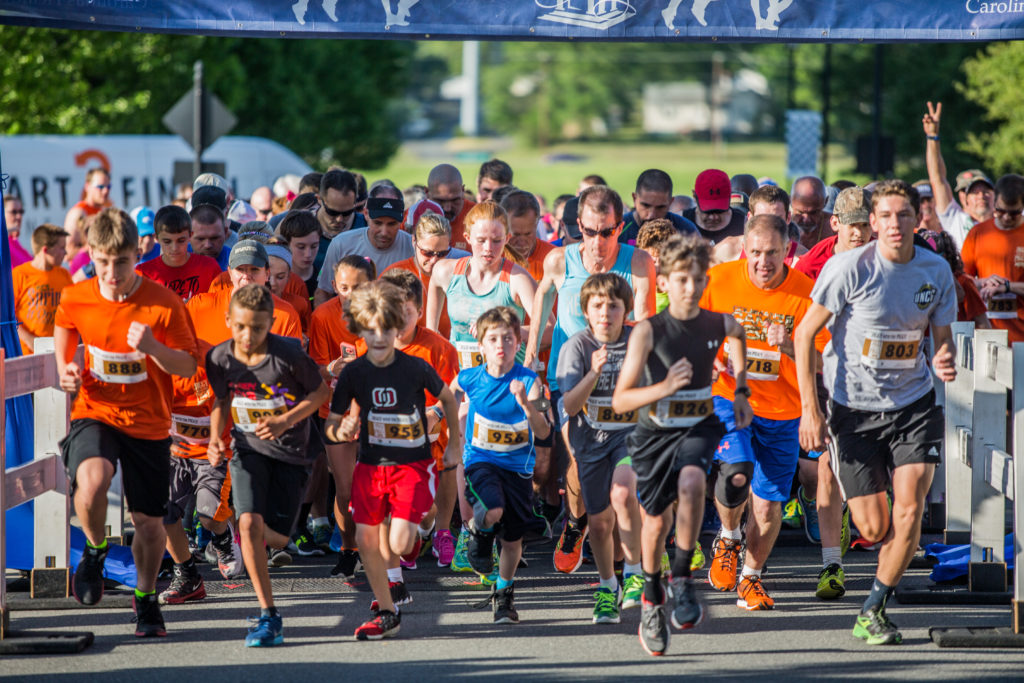
City-sponsored Jiggy with the Piggy 5K helps Kannapolis’ Healthy Living brand
By Kate Stevens. Three years ago, the city of Kannapolis, a former mill town also known for the North Carolina Research Campus, the Music Hall of Fame and hometown of Dale Earnhardt, was at a crossroad. The city’s population had exploded especially near its western edge along N.C. Hey. 73.
At the same time, city leaders were ready to undertake a revitalization project that would transform the city’s downtown into a regional attraction for sports, entertainment and performing arts.
But officials were concerned Kannapolis was in danger of not only losing its multi-faceted identity but growing without any strategic vision of economic development, quality of life or cohesive marketing plan.
“We wanted to make sure we didn’t become two cities,” said Annette Privette Keller, the city’s director of communications. “And we wanted to create an image and an identity to make citizens proud.”
In a move becoming more and more common among cities, towns and counties, city leaders decided to hire a marketing firm to research and develop a place brand for Kannapolis.
Today, the “Healthy Living” brand has been implemented across the city’s services and departments, from its new logo and slogan “Discover a Healthy Life,” to promoting 5K races.
Brands, once reserved for corporations selling a product, image or lifestyle, increasingly are telling the stories of towns, communities and counties.
Part of a specialized, unified marketing campaign designed to stand out from other locations, municipalities commission brands to attract visitors and improve economic development.
Rowan County, a mixture of rural farmland and bustling cityscape, touts its uniqueness with its “Be an Original” brand campaign.
And just last month, officials in Cabarrus County unveiled their marketing campaign for “America Thrives Here.”
“[A brand ] is not just a logo and a
tagline,” said Keller. “It’s something that is very strategic and very purposeful and methodical and a lot of work goes behind it.
The stakes are high.
A good brand can mean the difference in a major corporation headquartering in town or settling in a city more well-known because of an impressive marketing campaign and brand.
“Branding is a kind of way you, literally with Amazon, put it in one box,” said Jim Puckett, Mecklenburg County Board of Commissioners Vice Chairman.
Charlotte is competing against 99 other North American cities to convince mega retailer Amazon to build the company’s second headquarters, a $5 billion campus with up to 8 million square feet of office space and 50,000 employees, here.
In October, the Charlotte Regional Partnership, a non-profit organization dedicated to economic development, submitted its proposal in a custom-made wooden box with the regional economic development brand “Charlotte USA” written across the center.
The partnership, and its “Charlotte USA” brand, encompasses not only the city of Charlotte but 12 North Carolina counties, including Mecklenburg and Cabarrus counties, and four South Carolina counties, said Laura Foor, the partnership’s vice president of marketing and research.
When competing against cities like Nashville, Tennessee or Austin, Texas, it’s important to have a recognizable brand, Foor said.
And there is power in numbers, Foor continued.
“We’re just stronger as a region than we are as individual communities,” said Foor. “Our story is greater when we all collectively come together as one.”
But Puckett isn’t so sure that being a part of a regional brand is a good idea.
The inclusion of being a part of a brand like “Charlotte USA” can be an easy way for an outsider to find regional partners, but Mecklenburg County faces the “dilemma of not being part of the current brand,” said Puckett.
While Puckett said it is city of Charlotte representatives who cut ribbons and take credit for economic development, it’s actually entities like Mecklenburg County that end up paying more in financial concessions as incentives to draw new companies to the area, Puckett said.
If a business were to relocate to the area, it would also be places like Mecklenburg County that would need to address infrastructure improvements and new school construction, Puckett said.
“The county has a real, hard cost to growth,” Puckett said.
Puckett also believes drawing Amazon to the area may not be that beneficial.
“Fifty thousand people in New York City isn’t too big,” said Puckett. “Fifty thousand people in Charlotte might be too big.”
Puckett also wondered if competing Amazon proposals from Raleigh/Durham, Hickory and the state’s Triad region of Winston-Salem, Greensboro and High Point, are counterproductive.
“I just wonder if our brands don’t get in the way,” Puckett said.
Nationally, the state’s brand has been hurt by the controversy over the HB2 “bathroom bill,” both Puckett and Foor agreed.
“The fact the state can implode over this doesn’t give me a lot of confidence on the big issues,” said Puckett.
While North Carolina is still considered a strong business location, “I do think that legislation has definitely hurt us,” Foor said. “It definitely has.”
Keller, who has also worked on brand campaigns for the city of Concord and town of Matthews, said she began to see an uptick in locales branding themselves around the 2007 recession.
Simultaneously, Keller saw a decline in traditional media and an increase in municipalities hiring communications director to, in part, better utilize social media platforms to help control the locale’s image.
“There’s been a real understanding you have to be in charge of your story,” said Keller.
Place brands are more significant today than ever before, particularly how external audiences, including corporations, go about searching for locations using the Internet, said Mark Vogel, senior partner of St. Louis, Missouri-based Avant Marketing Group, the company that developed the “America Thrives Here” brand positioning for Cabarrus County.
Branding also defines the purpose and mission for the area’s internal audience made up of county employees, residents and business owners, said Vogel.
The Avant Marketing team spent two weeks in Cabarrus County interviewing residents, employees and conducting focus groups and surveys to be able to tell the county’s story, Vogel said.
Many times, communities seek a brand because economic development is lackluster, Vogel said. But Cabarrus County, home to the cities of Kannapolis and Concord, had the opposite problem, he continued. People were flocking to the area and Cabarrus County officials wanted to manage it the right way.
From 2010-16, Cabarrus County’s population increased 13.3 percent to 201,590 people, according to U.S. Census data released in 2016.
But, the county did have a “fractured identity,” Vogel said, and needed a way to tie together future economic development with its traditional motor sports attractions and gold rush history.
Cabarrus County is actively courting Amazon to build its headquarters there and was a part of the bid sent by the Charlotte Regional Partnership, said Cabarrus County Board of Commissioners Chairman Steve Morris.
“We have the ability to very quickly react to their needs and produce a very attractive place for them to locate,” said Morris. Recently unveiled in October, Cabarrus County’s “America Thrives Here” branding campaign helps the county compete with other places for quality jobs and businesses and serves as a reminder the county is a place future employees will want to live and thrive, said county manager Mike Downs.
After studying focus groups, surveys and interviews about the county’s identity, the brand focuses on four key community values: Faith, family, collaboration and tradition, said Kasia Faryna Thompson, Cabarrus County communications and outreach manager.
“It’s very authentic to who are are,” said Thompson. The total cost to the county was $70,000.
James Meacham, CEO of the Rowan County Tourism Development Authority, said the authority spent $500,000 over three years in part working with Nashville, Tennessee-based marketing firm Chandlerthinks to research, develop and roll out the county’s new brand campaign, “Be an Original.”
The campaign received a lot of feedback about the community’s strong spirt of individualism where people still connect with each other despite differences, Meacham said.
Measuring the success of such a branding campaign is tricky but Meacham said the tourism development authority looks at how successfully the county has adopted the campaign and how word of mouth about the campaign has spread.
“That’s a success factor we can’t put a price on,” said Meacham.
A better measuring stick is the county’s digital platforms which have seen higher traffic and a longer time spent by users since the new campaign was introduced last fall, Meacham said.
“If you want the best for your community, you have to be willing to invest in your community… Our board felt Rowan County was worth it,” said Meacham.
The city of Kannapolis, split between Cabarrus and Rowan counties, spent just under $100,000 on its branding campaign, said Keller.
She said she knows the campaign has been successful in part due to word of mouth from visitors, compliments on the city’s new street signage and positive comments on social media, Keller said. Through branding research that began three years ago, city officials learned people felt Kannapolis was a healthy place to live physically, mentally and socially.
“People felt there is an emphasis on health,” said Keller, mentioning the North Carolina Research Campus and the Cabarrus Health Alliance.
The city’s slogan, “Discover a Healthy Life,” has been implemented on new street signage and a new logo featuring the City Hall cupola is now featured on employee shirts and stationary.

Discussion
No comments yet.